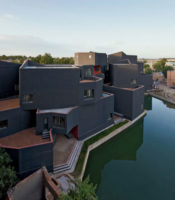When Jeff Taylor and B. Alex Miller met in a studio class while working toward their M.Arch. degrees at MIT, “It was love at first sight,” jokes Miller. “It was one of those weird situations where we had a couple of sit-down conversations after teaching hours, and almost immediately we thought, ‘We should work together.’ ” They founded their firm in 2002, before graduation, and have since completed a number of projects that highlight materiality and craft.
Both from working-class communities in the middle of the country (Miller grew up in Illinois; Taylor hails from Colorado), the pair share an affinity for hand-tooled architecture with conceptual underpinnings. “We developed a good relationship in our studio work and could offer crits to each other in a way that was really productive,” says Taylor. That closeness endures — it is especially evident when the two finish each other’s sentences. The partners have developed a design process that involves honing a concept verbally until it works. “The more we throw these ideas around, the more comfortable I am with them,” says Miller.
On most of their projects to date, one of the two principals will serve as the primary client contact. According to Taylor, his battles with Miller usually “have to do with one of us feeling more concerned or fearful about the client’s preconceptions of the provocative ideas we propose. One of us will say, ‘You can’t do that — the client’s going to kill us!’ And the other guy will say, ‘No, we have to do this!’ ”
Taylor, who had years of experience as a contractor prior to matriculating at MIT, has served as the client liaison on most of their projects in the area of the Berkshires, in Massachusetts, where he lives (Miller lives in Brooklyn, New York). The firm has built several projects in a rural swath of western Massachusetts, where most locals have conservative architectural tastes. When the pair remodeled one school in the Berkshires with a Cor-Ten steel skin, people would drive by and ask when the architects intended to paint it. One neighbor planted a screen of trees between the properties to block his view of the new building; others called building inspectors to complain. “It’s not that the work was so radical,” says Taylor. “It’s just the context. In the end, we’re provoking thought about architecture. You come across people who love it, and people who can’t stand it. That’s feedback that we’re doing something successful.”
Most of the firm’s built work to date has been on small, straightforward spaces — gallery installations, residential additions, a lounge. Taylor and Miller’s creative process, then, tends to begin not by discussing function, but by selecting materials. “One of the first questions we ask ourselves is not what the program is, but what it’s made of,” says Miller.
After determining texture, they move onto tectonics, using both digital design and physical mock-ups to investigate the relationship between a project’s parts and its final form. Through careful ordering and repetition, mean materials (for example, cedar slats, strands of hemp rope, or tension cable) converge to make a whole that obscures the individual parts, yet is a pure expression of them. “We don’t mind using dumb things to make smart architecture,” Miller says. “It’s a challenge.”
It’s also, more often than not, extremely economical. To save money, they do much of their own fabrication in their workshops in Pittsfield, Massachusetts, and Brooklyn, which has the added benefit of giving them more control over each element of their design. The pair is skilled at turning budget constraints into design conceits: “When we’re forced to pare things down, there’s a lot of care required to amplify the architecture and get it right,” says Miller.






















Post a comment to this article
Report Abusive Comment